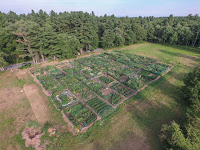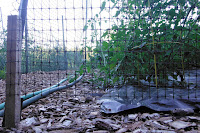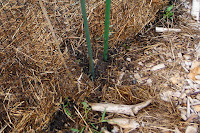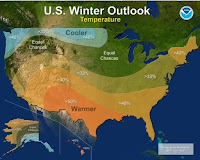 |
Marmota monax, aka woodchuck
(among many aliases) |
Only slightly less
predictable than the yearly return of the swallows to Mission San Juan
Capistrano each March 19 is the mid-July annual pilgrimage of woodchucks to the
Medfield Community Garden in Massachusetts.
Unlike the California event, tourists have yet to take notice of the
east coast invasion by multiple members of the extended Marmota monax family, so there is still time to get a ringside
seat.
While I had not circled
the event on my calendar, I was not the least bit surprised to receive an email
Thursday morning from one of the plot holders at the community garden that
Betty and I manage. The gardener,
Heather, wrote, “When I arrived at the garden this morning there
was a chubby woodchuck munching away in my neighbor's (Ed’s) garden. It looked
like he went under the fence so it will need some repairs…”
My immediate response
was to dash off a memo to each of the 75 gardeners who grows vegetables in the
town-owned garden, reprinting Heather’s email, and warning everyone that the
woodchucks (there are always more than one) would not be to content to eat just
Ed’s vegetables. I warned he
or she will follow their nose and seek out other, vulnerable gardens and will
likely post reviews on Yelp! That, in turn, generated a panicked response
from Ed, who said he is on vacation, and asked if I could effect some of those
emergency repairs. I said I would do so.
Before I continue with
this story, here is what humankind knows about woodchucks. The first thing is that they have many
aliases. They have fake IDs identifying
themselves as groundhogs, whistlepigs, marmots, and half a dozen lesser-known
names. They are endemic in Canada and
call home a swath of the United States running roughly from Minnesota south to
Arkansas; swooping down into Mississippi, Alabama, and North Carolina. They are thick as thieves in New England. They are, technically speaking, a large
ground squirrel.
 |
The Medfield Community Garden is
more or less a woodchuck's idea
of heaven |
Woodchucks prefer open
country and the edges of woodlands. They
live in underground burrows with multiple entrances. The Medfield Community Garden occupies a
one-acre site in a former farm field (the aforementioned ‘open country’)
surrounded, in turn, by woodlands that are protected town conservation
land. And, did I mention that hunting is
prohibited in Medfield? “Location,
location, location.”
In my warning memo, I
wrote that everyone should make certain the fence around their garden was
buried. I said, “Yes,
I urged you to do this back in April, and most of you took that advice to
heart. So, the real advice is to make
certain your fence is still buried in the ground at least three or four
inches. If it is not, or if you did not
bury it because it was too much trouble or you assumed the only hungry wildlife
you needed to thwart were sheep or capybaras, take the time to bury it now.”
 |
The gap under this fence at the
community garden is three inches.
Anything can crawl in and out. |
A quick survey of the
community garden this morning revealed that my estimate was a little
optimistic. Fewer than half of the 75
gardeners had buried their fences; including, of course, Ed. While Ed’s fence at least sat on the ground,
many fences in the garden began a good two or three inches above the soil line.
I further wrote, “If
your plot is on the perimeter of the community garden,
consider driving wood or bamboo stakes through vulnerable points of entry. Make them four to six inches apart and drive
them down at least six inches.
Woodchucks are fundamentally lazy.
They won’t try to figure out why they can’t get into your garden;
they’ll just go for easier pickings. And
make certain you gate isn’t the Achilles Heel of your protection plan. Make certain it is tight at the bottom, has
no obvious gaps, and consider those wood or bamboo stakes.”
 |
| I repaired Ed's garden as best I could |
This is what I did for
Ed. I found the two points of entry
where the woodchuck had moseyed in, and added ten or twelve stakes to seal
those points. Of course, since none of
Ed’s fence is buried, that woodchuck or his cousin Ralphie has another 96 liner
feet of fence to crawl under.
 |
Bobbex-R won't kill
woodchucks, but it will
annoy them mightily |
My
next piece of advice involved chemical warfare.
“Invest in a spray bottle of Bobbex-R. Bobbex-R
doesn’t kill woodchucks; it just smells awful to them, causing them to avoid
your garden for a more palatable one. Apply
it around the perimeter of your garden – not on anything you plan to eat. A 32-ounce ready-to-spray bottle will cover
1,000 square feet, which means a full-size plot can be sprayed ten times; a
half-size plot can be sprayed 14 times.
As an application lasts two to three weeks, one bottle will see you
through to the end of the gardening season.”
Will
people in the community garden buy a rodent repellent? The uniform price seems to be $32.47 for that
ready-to-spray solution. Given that each
garden has several hundred dollars of produce growing in it, it seems like a
bargain. I sniffed the air this morning
for the tell-tale scent of putrefied eggs and garlic. Nothing so far.
“If
you find a place in your fence where an animal has entered, repair the site
immediately, which does not mean piling up mulch or stone around the
affected area,” I wrote. “Woodchucks may look dumb, but
they’re not. They have good noses,
unerringly return to the same locale, and pawing aside some loose debris helps
build up an appetite.”
This morning, I observed several gardens with
closely-spaced wooden stakes around what may have been previously unnoticed
entry sites. I also found a depressing
number of places where gardeners had piled up mulch. I have to learn to make my declarative
sentences shorter.
My last piece of advice to my troops was this: “If all else fails, be prepared to stand
guard around your garden for the rest of the season with two metal trash can
lids at the ready. I do not advocate
this approach.”
It isn’t that banging garbage can lids is
time-consuming (although it would likely get very old, very quickly). It is that I can imagine that, rather than
driving woodchucks from the vicinity of the garden, it would encourage families
of adults and chucklings to gather at the periphery of the site, spreading
blankets and bringing picnics, waiting for the rest of the band to arrive.




















